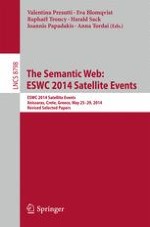2014 | Buch
The Semantic Web: ESWC 2014 Satellite Events
ESWC 2014 Satellite Events, Anissaras, Crete, Greece, May 25-29, 2014, Revised Selected Papers
herausgegeben von: Valentina Presutti, Eva Blomqvist, Raphael Troncy, Harald Sack, Ioannis Papadakis, Anna Tordai
Verlag: Springer International Publishing
Buchreihe : Lecture Notes in Computer Science
